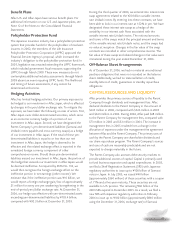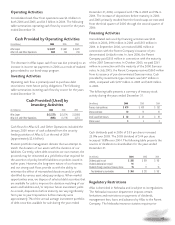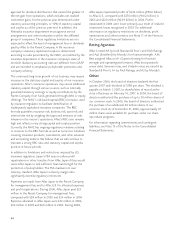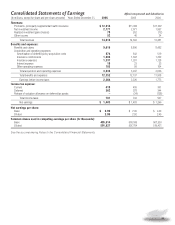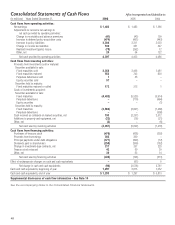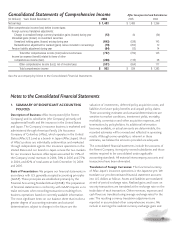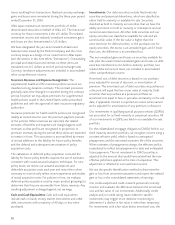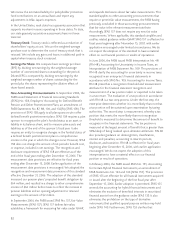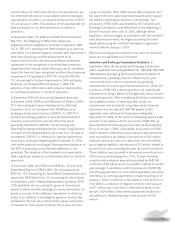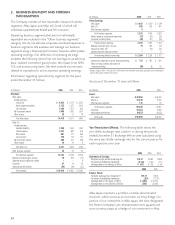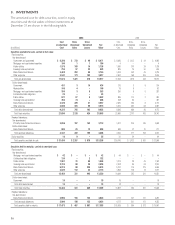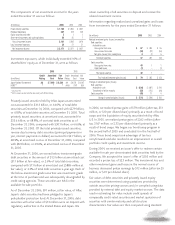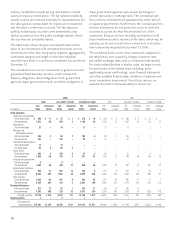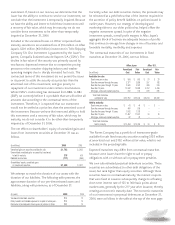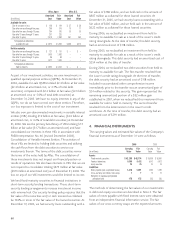Aflac 2006 Annual Report Download - page 55
Download and view the complete annual report
Please find page 55 of the 2006 Aflac annual report below. You can navigate through the pages in the report by either clicking on the pages listed below, or by using the keyword search tool below to find specific information within the annual report.
51
process includes evaluating the length of time and the extent
to which amortized cost exceeds fair value, the prospects and
financial condition of the issuer, and our evaluation for a
potential recovery in fair value, among other factors. This
process is not exact and requires consideration of risks such as
credit risk, which to a certain extent can be controlled, and
interest rate risk, which cannot be controlled. Therefore, if an
investment’s amortized cost exceeds its fair value solely due to
changes in interest rates, impairment may not be appropriate.
If, after monitoring and analyses, management believes that a
decline in fair value is other than temporary, we adjust the
amortized cost of the security and report a realized loss in the
consolidated statements of earnings.
We lend fixed-maturity securities to financial institutions in
short-term security lending transactions. These securities
continue to be carried as investment assets on our balance
sheet during the terms of the loans and are not reported as
sales. We receive cash or other securities as collateral for such
loans. For loans involving unrestricted cash collateral, the
collateral is reported as an asset with a corresponding liability
for the return of the collateral. For loans collateralized by
securities, the collateral is not reported as an asset or liability.
Deferred Policy Acquisition Costs: The costs of acquiring
new business are deferred and amortized with interest over
the premium payment periods in proportion to the ratio of
annual premium income to total anticipated premium income.
Anticipated premium income is estimated by using the same
mortality, persistency and interest assumptions used in
computing liabilities for future policy benefits. In this manner,
the related acquisition expenses are matched with revenues.
Deferred costs include the excess of current-year commissions
over ultimate renewal-year commissions and certain direct and
allocated policy issue, underwriting and marketing expenses.
All of these costs vary with and are primarily related to the
production of new business.
Policy Liabilities: Future policy benefits represent claims that
may occur in the future and are computed by a net level
premium method using estimated future investment yields,
persistency and recognized morbidity and mortality tables
modified to reflect our experience, including a provision for
adverse deviation. These assumptions are generally established
at the time a policy is issued.
Unpaid policy claims are estimates computed on an
undiscounted basis using statistical analyses of historical claims
experience adjusted for current trends and changed
conditions. The ultimate liability may vary significantly from
such estimates. We regularly adjust these estimates as new
claims experience emerges and reflect the changes in
operating results in the year such adjustments are made.
Income Taxes: Income tax provisions are generally based on
pretax earnings reported for financial statement purposes,
which differ from those amounts used in preparing our
income tax returns. Deferred income taxes are recognized for
temporary differences between the financial reporting basis
and income tax basis of assets and liabilities, based on enacted
tax laws and statutory tax rates applicable to the periods in
which we expect the temporary differences to reverse.
Derivatives: We have limited activity with derivative financial
instruments. We do not use them for trading purposes, nor do
we engage in leveraged derivative transactions. At December 31,
2006, our only outstanding derivative contracts were interest
rate swaps related to our ¥20 billion variable interest rate
Uridashi notes and cross-currency swaps related to our $450
million senior notes (see Notes 4 and 7).
We document all relationships between hedging instruments
and hedged items, as well as our risk-management objectives
for undertaking various hedge transactions. This process
includes linking derivatives that are designated as hedges to
specific assets or liabilities on the balance sheet. We also
assess, both at inception and on an ongoing basis, whether the
derivatives and nonderivatives used in hedging activities are
highly effective in offsetting changes in fair values of the
hedged items. The assessment of hedge effectiveness
determines the noncash accounting treatment of changes in
fair value.
We have designated our cross-currency swaps as a hedge of
the foreign currency exposure of our investment in Aflac
Japan. We include the fair value of the cross-currency swaps in
either other assets or other liabilities on the balance sheet. We
report the changes in fair value of the foreign currency
portion of our cross-currency swaps in other comprehensive
income. Changes in the fair value of the interest rate
component are reflected in other income in the consolidated
statements of earnings.
We have designated our interest rate swaps as a hedge of the
variability of the interest cash flows associated with the variable
interest rate Uridashi notes. We include the fair value of the
interest rate swaps in either other assets or other liabilities on
the balance sheet. We report the changes in fair value of the
interest rate swaps in other comprehensive income as long as
they are deemed effective. Should any portion of the swap be
deemed ineffective, that value would be reported in other
income in the consolidated statements of earnings.
Policyholder Protection Fund and State Guaranty
Association Assessments: In Japan, the government has
required the insurance industry to contribute to a policyholder
protection fund. We recognize a charge for our estimated
share of the industry’s obligation once it is determinable.


